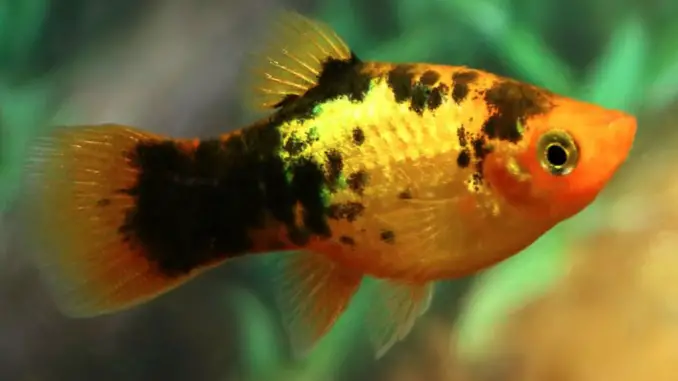
Platy fish are a common group of aquarium fish from Central America. Their hardiness and peaceful temperament make them a popular choice for beginner aquarists choosing their first fish.
Platy fish have been extensively bred, so they come in many colors and patterns, with names to describe them.
TABLE OF CONTENTS
- Bumblebee Platy Fish
- Gold Red Platy Fish
- Salt and Pepper Platy Fish
- Parrot Platy Fish
- Hifin Platy Fish
- Pintail Platy Fish
- Dalmatian Platy Fish
- Rainbow Platy Fish
- Calico Platy Fish
- Neon Gold Calico Platy Fish
- Comet Platy Fish
- Green Lantern Platy Fish
- Malibu Sunset Platy Fish
- Black Hamberg Platy Fish
- Tuxedo Platy Fish
- Panda Platy Fish
- Neon Blue Wagtail Platy Fish
- Mickey Mouse Platy Fish
- Swordtail Platy Fish
- Choosing & Caring for Different Platy Fish Types
Bumblebee Platy Fish
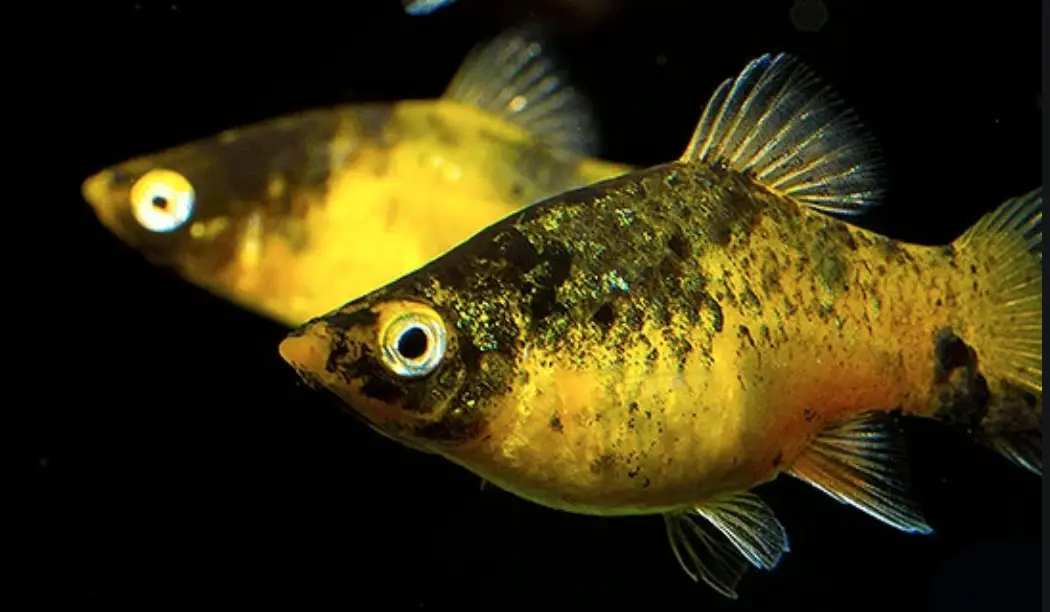
| Care level: | Temperament: | Color: | Lifespan: | Size: |
| Easy | Peaceful | Yellow and black | 3–5 years | 3 inches |
| Water temperature: | Water pH: | Tank size: | Diet: | Scientific name: |
| 72–75°F | 6.8–8.0 | 10 gallons | Omnivore | Xiphophorus maculatus |
A bright yellow fish is arguably the best way to introduce color to your tank, and the bumblebee platy stands out with its bright yellow body and black head. Some bumblebee fish have black spots that encroach upon their body.
Like most platy fish varieties, bumblebee platy fish are easy to care for and accept most aquarium foods.
Gold Red Platy Fish
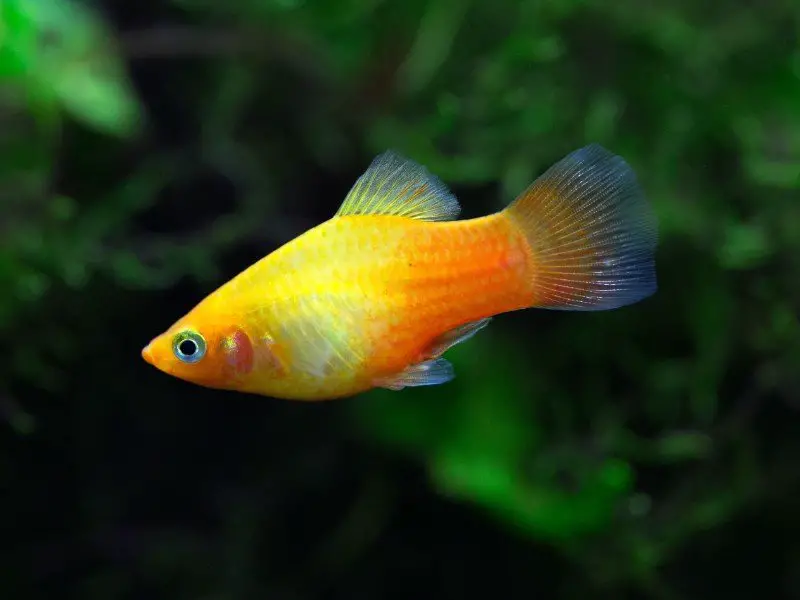
| Care level: | Temperament: | Color: | Lifespan: | Size: |
| Easy | Peaceful | Gold and red | 3–5 years | 3 inches |
| Water temperature: | Water pH: | Tank size: | Diet: | Scientific name: |
| 72–75°F | 6.8–8.0 | 10 gallons | Omnivore | Xiphophorus maculatus |
The gold red platy fish is named for its gradient coloring. The front half of the body is light gold in color, while the rear half of the fish turns dark red. The gold red’s fins are black or clear.
Gold red platy fish have been selectively bred in different colors. If you like the pattern but not the gold and red colorations, you may be able to find a local stock in different colors.
Blues and greens are popular variations of the gold red platy. However, the gold red platy fish is well-loved for its powerful black markings.
Salt and Pepper Platy Fish
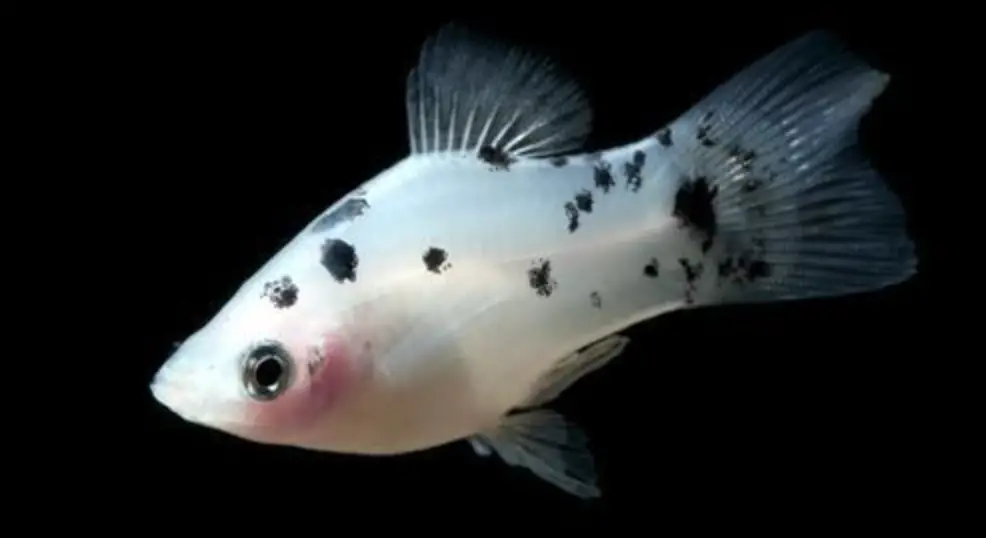
| Care level: | Temperament: | Color: | Lifespan: | Size: |
| Easy | Peaceful | Various, with black spots | 3–5 years | 3 inches |
| Water temperature: | Water pH: | Tank size: | Diet: | Scientific name: |
| 72–75°F | 6.8–8.0 | 10 gallons | Omnivore | Xiphophorus maculatus |
Salt and pepper platies are an excellent choice for beginners because they don’t have any special care requirements.
Named after the pattern across their body, salt and pepper platies have back spots scattered over colorful scales.
The color of the body beneath the black spots can vary, and the colors available to you will depend on the stock at your local fish store.
Parrot Platy Fish
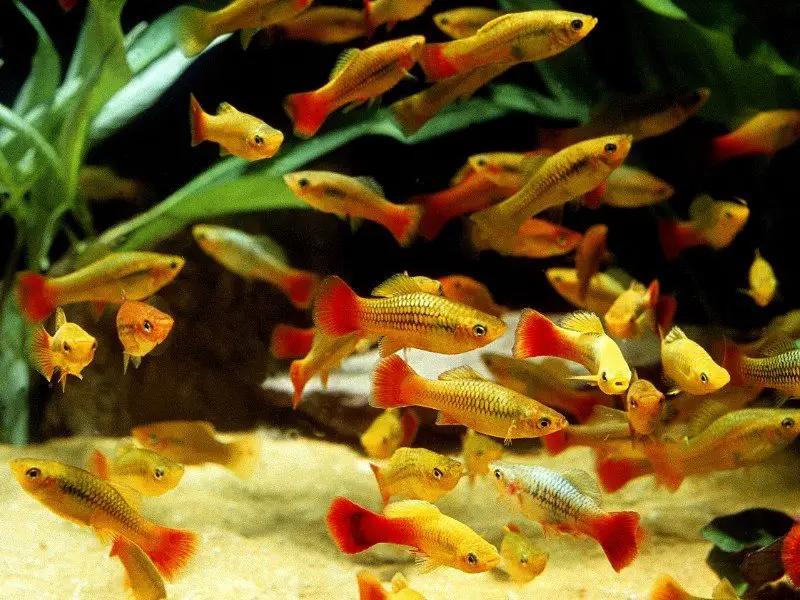
| Care level: | Temperament: | Color: | Lifespan: | Size: |
| Easy | Peaceful | Orange | 3–5 years | 3 inches |
| Water temperature: | Water pH: | Tank size: | Diet: | Scientific name: |
| 72–75°F | 6.8–8.0 | 10 gallons | Omnivore | Xiphophorus maculatus |
The parrot platy fish is usually orange or gold, but it can be found in other colors too.
Parrot platies are easily identified by the v-shaped triangular marking on their tails, and two black stripes that run along the edges of the tail.
Hifin Platy Fish
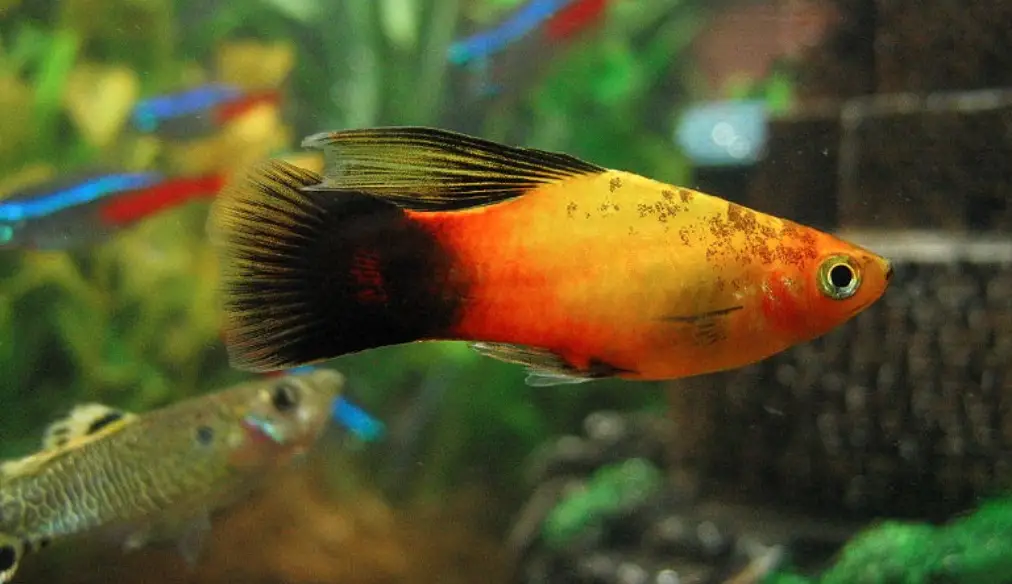
| Care level: | Temperament: | Color: | Lifespan: | Size: |
| Easy | Peaceful | Various | 3–5 years | 3 inches |
| Water temperature: | Water pH: | Tank size: | Diet: | Scientific name: |
| 72–75°F | 6.8–8.0 | 10 gallons | Omnivore | Xiphophorus maculatus |
Hifin platy fish – also called high fin, moonfish, or sailfin platies in some pet stores – are an extravagant option as a first fish. While many beginner platy species lack flair, hifin platies catch the eye with their exceptionally tall dorsal fins.
The hifin platy’s large fins leave this species at a high risk of fin-nipping by its tank mates, so avoid housing hifin platys with other species that are notorious fin-nippers.
Regularly sit and watch the hifin platy fish to check for signs of damage on their fins. This could be a large wound or rip, or some slight fraying along the edges of the fin.
Hifin platies can be found in most of the same colors and patterns of other types of platy fish. For example, many platy variations have been selectively bred to have the tall fins of the hifin platy fish and the pattern of the salt and pepper platy fish.
Pintail Platy Fish
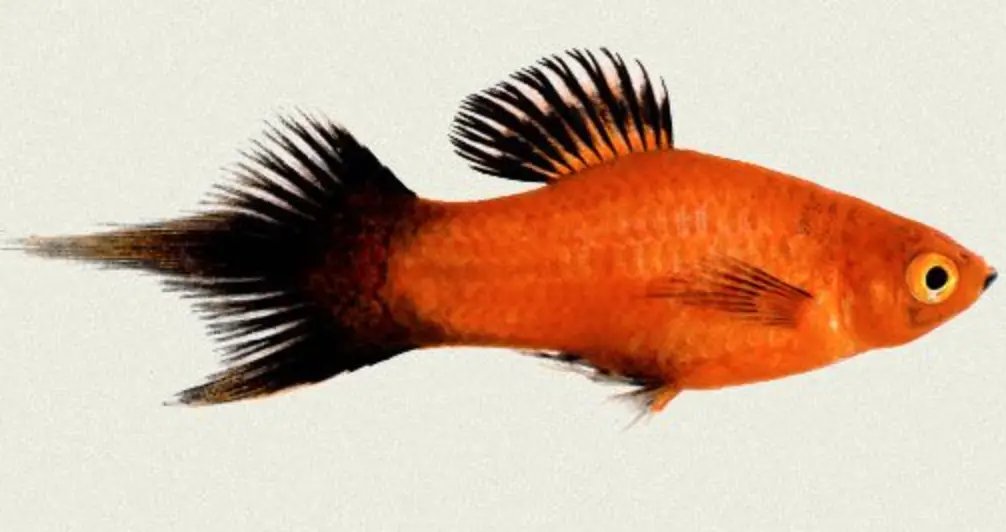
| Care level: | Temperament: | Color: | Lifespan: | Size: |
| Easy | Peaceful | Various | 3–5 years | 3 inches |
| Water temperature: | Water pH: | Tank size: | Diet: | Scientific name: |
| 72–75°F | 6.8–8.0 | 10 gallons | Omnivore | Xiphophorus maculatus |
Like the hifin platy fish, pintail platies are known for their unique tails that are elongated through the midsection.
This long tail can cause people to confuse this pintail platy with swordtail platies. You can distinguish a swordtail platy fish by their extension along the bottom of their tail, as opposed to through the middle (swordtail platies).
Pick your favorite among the many color and pattern variations that pintail platies come in.
Though the pintail platy’s tail makes this platy longer than other platy fish, the pintail still fits comfortably in a 10-gallon tank.
Dalmatian Platy Fish
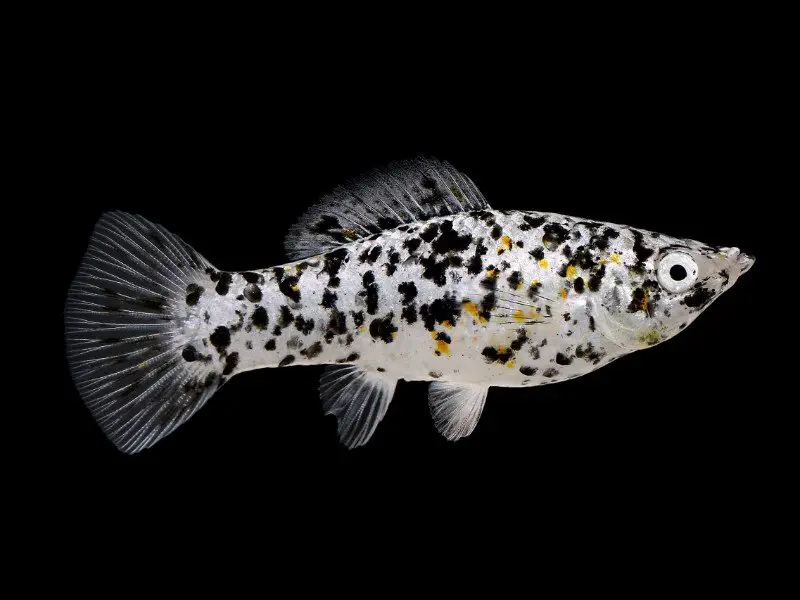
| Care level: | Temperament: | Color: | Lifespan: | Size: |
| Easy | Peaceful | White with black spots | 3–5 years | 3 inches |
| Water temperature: | Water pH: | Tank size: | Diet: | Scientific name: |
| 72–75°F | 6.8–8.0 | 10 gallons | Omnivore | Xiphophorus maculatus |
The dalmatian platy fish, known for its namesake, is easy to identify by its white body and black spots.
Though the dalmation platy doesn’t introduce much color to the aquarium, the contrasting white and black pattern makes for a good attention-grabber.
Like all platies, dalmatian platy fish should be kept in groups of at least six. You can mix different color variations of dalmation platy fish, but don’t mix dalmation platies with other platy species.
Rainbow Platy Fish
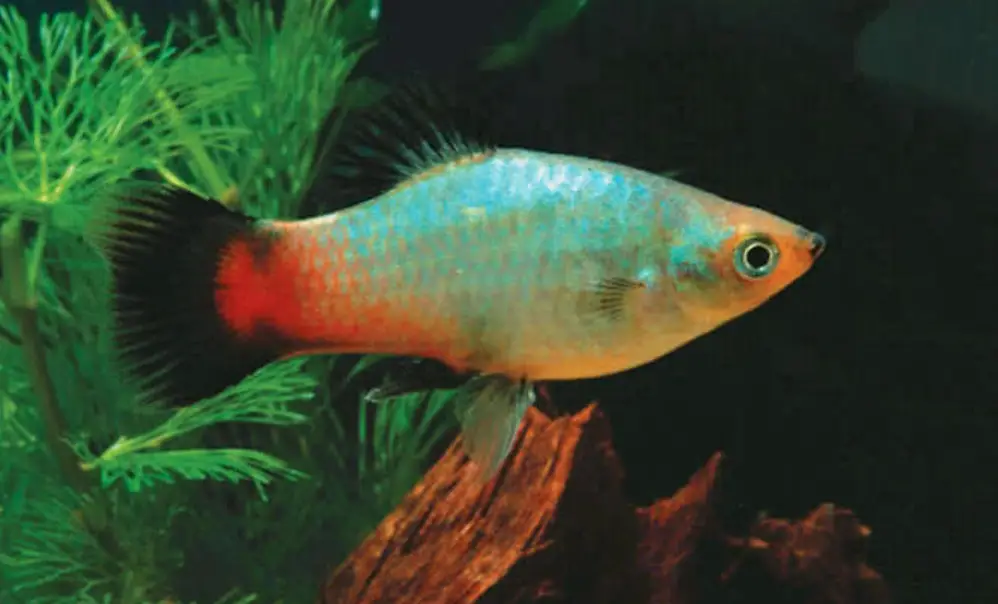
| Care level: | Temperament: | Color: | Lifespan: | Size: |
| Easy | Peaceful | Rainbow | 3–5 years | 3 inches |
| Water temperature: | Water pH: | Tank size: | Diet: | Scientific name: |
| 72–75°F | 6.8–8.0 | 10 gallons | Omnivore | Xiphophorus maculatus |
Rainbow platy fish display a range of iridescent colors across their bodies that sparkle under aquarium lights and contrast beautifully against their black tail and pale head.
The rainbow platy is a perfect species for aquarists who want as many different colors in their tank as possible. The sparkling of the iridescent colors is exaggerated when these platies swim together.
Calico Platy Fish
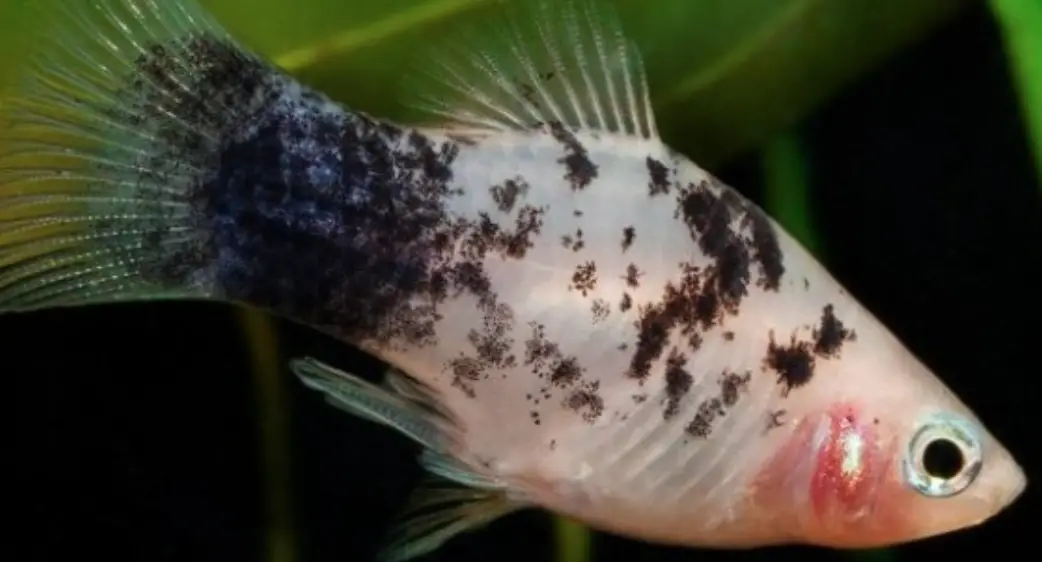
| Care level: | Temperament: | Color: | Lifespan: | Size: |
| Easy | Peaceful | Various, often blue | 3–5 years | 3 inches |
| Water temperature: | Water pH: | Tank size: | Diet: | Scientific name: |
| 72–75°F | 6.8–8.0 | 10 gallons | Omnivore | Xiphophorus maculatus |
The calico platy fish is distinguished from other platies by a dense patch of black spots over the tail, that spread up the body and peter out near the head.
You can choose calico platy fish in the color that suits you. Blue is the most common.
Neon Gold Calico Platy Fish
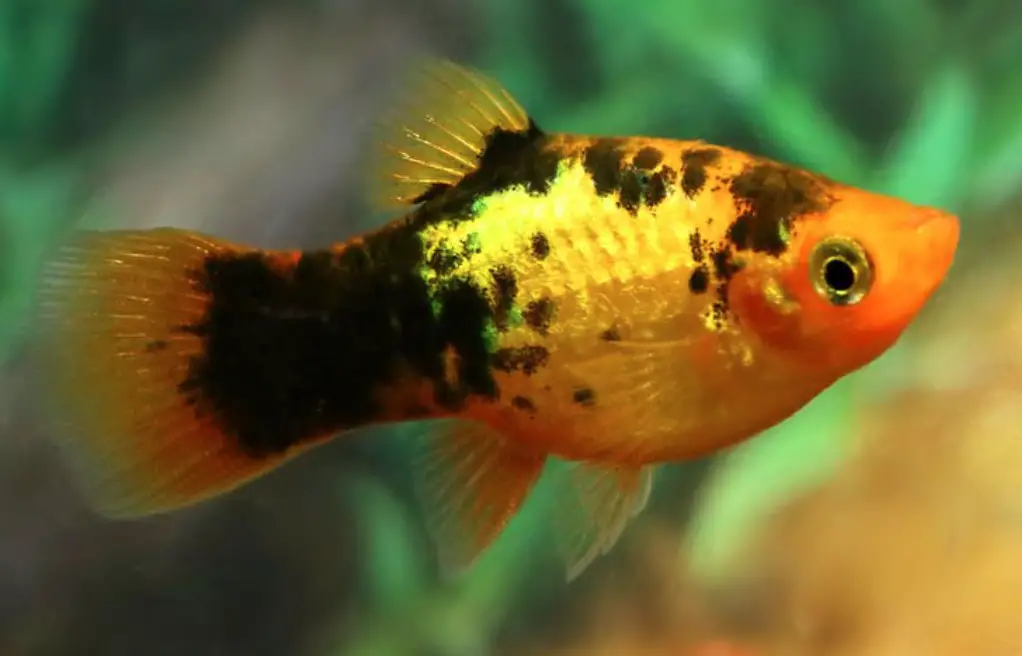
| Care level: | Temperament: | Color: | Lifespan: | Size: |
| Easy | Peaceful | Gold | 3–5 years | 3 inches |
| Water temperature: | Water pH: | Tank size: | Diet: | Scientific name: |
| 72–75°F | 6.8–8.0 | 10 gallons | Omnivore | Xiphophorus maculatus |
The neon gold platy is one of the most beautiful varieties of the calico platy fish. Neon gold calico platies have golden-orange bodies covered by the typical calico spots.
The neon gold calico’s color and pattern combination resembles that of a koi carp, and is a design for which many aquarium species have been bred.
Comet Platy Fish
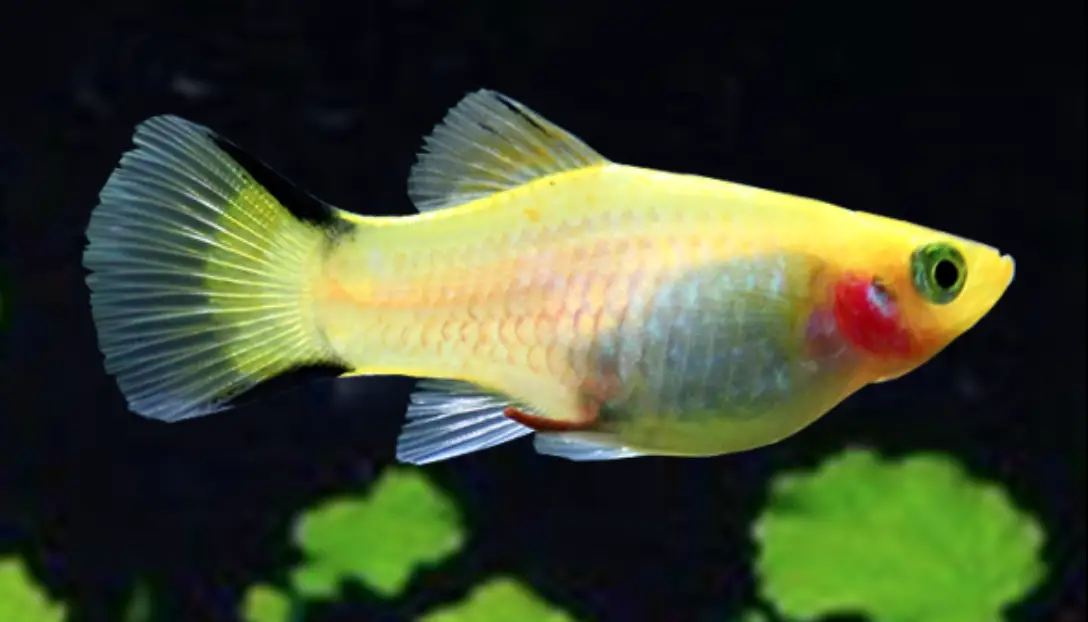
| Care level: | Temperament: | Color: | Lifespan: | Size: |
| Easy | Peaceful | Various, with black bars on tail | 3–5 years | 3 inches |
| Water temperature: | Water pH: | Tank size: | Diet: | Scientific name: |
| 72–75°F | 6.8–8.0 | 10 gallons | Omnivore | Xiphophorus maculatus |
The comet platy fish is notable for the black bar print on its tail fin. A bold black stripe runs from the beginning of both the top and bottom edges of the comet’s tail, to the tail fringe. Because of its markings, the comet platy sometimes goes by the name twin bar platy.
Comet platies come in a range of colors, and yellow or orange are the most popular. Though the colors are pale, they create a great contrast with the fish’s black bar printing.
Green Lantern Platy Fish
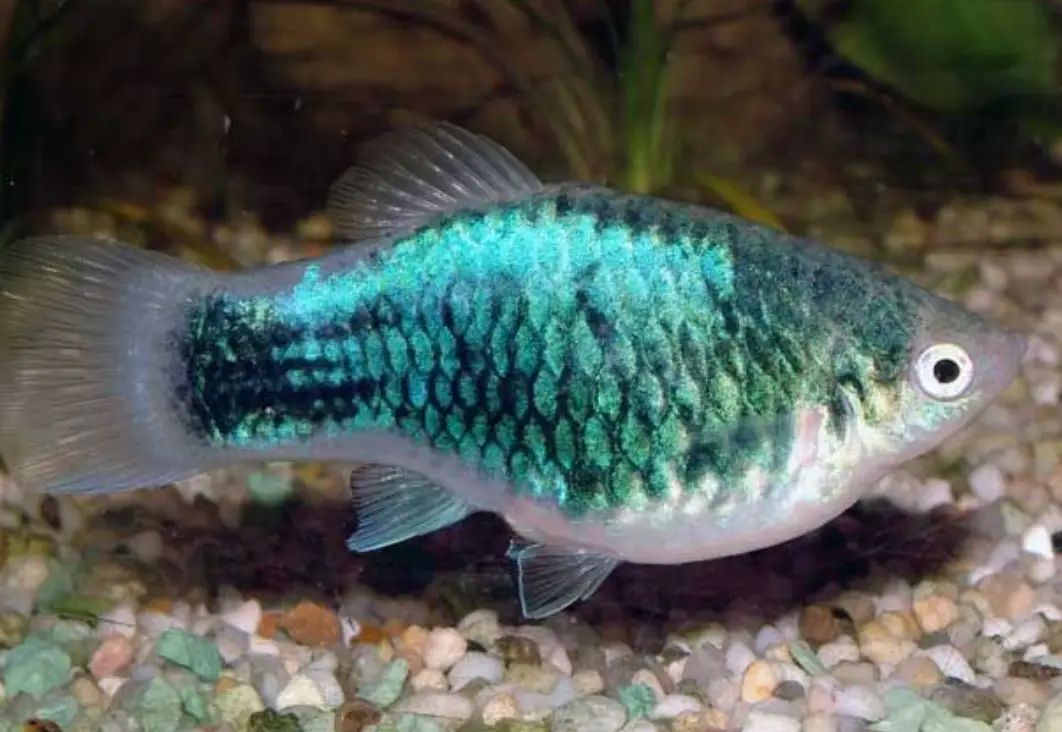
| Care level: | Temperament: | Color: | Lifespan: | Size: |
| Easy | Peaceful | Iridescent green | 3–5 years | 3 inches |
| Water temperature: | Water pH: | Tank size: | Diet: | Scientific name: |
| 72–75°F | 6.8–8.0 | 10 gallons | Omnivore | Xiphophorus maculatus |
The body of the green lantern platy is iridescent. When swimming beneath aquarium lights, the scales shine silver, blue, and green.
The green lantern platy is a rare species because it is not as widely bred as other types – which makes it all the more desirable.
Malibu Sunset Platy Fish
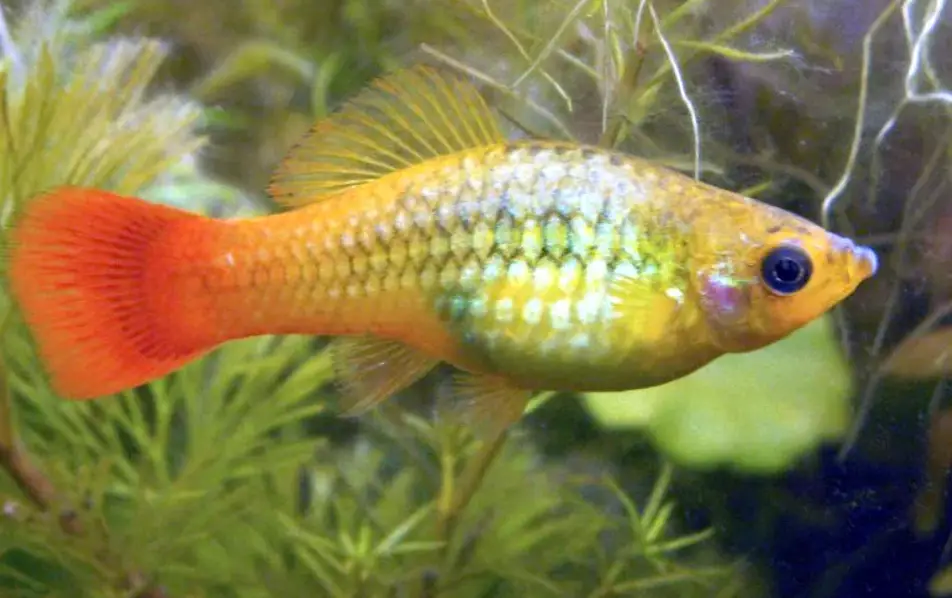
| Care level: | Temperament: | Color: | Lifespan: | Size: |
| Easy | Peaceful | Orange and silver | 3–5 years | 3 inches |
| Water temperature: | Water pH: | Tank size: | Diet: | Scientific name: |
| 72–75°F | 6.8–8.0 | 10 gallons | Omnivore | Xiphophorus maculatus |
The Malibu sunset platy fish has two colors separated at the middle of the body. The front of the fish is silver with flecks of blue, and the rear of the body is a deep orange. These colors splash together over the fins, too.
Malibu sunsets display a simple design that complements other colors in the home aquarium.
Black Hamberg Platy Fish

| Care level: | Temperament: | Color: | Lifespan: | Size: |
| Easy | Peaceful | Black | 3–5 years | 3 inches |
| Water temperature: | Water pH: | Tank size: | Diet: | Scientific name: |
| 72–75°F | 6.8–8.0 | 10 gallons | Omnivore | Xiphophorus maculatus |
Black Hamberg platy fish are almost entirely black, with exception to their clear fins and pale orange head and belly.
The black coloring may sound overpowering, but the Black Hamberg’s scales shine under aquarium lighting. This creates bright flashes as the fish dart around the tank.
Tuxedo Platy Fish
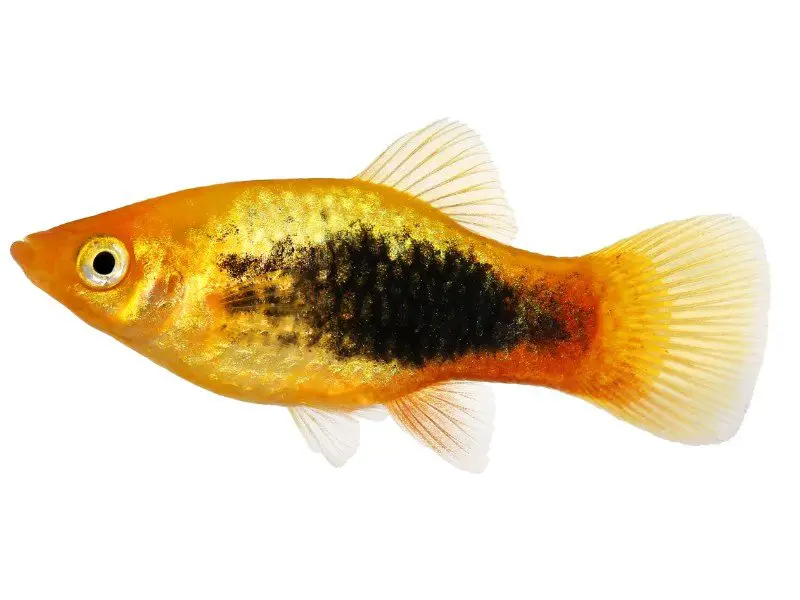
| Care level: | Temperament: | Color: | Lifespan: | Size: |
| Easy | Peaceful | Black, various | 3–5 years | 3 inches |
| Water temperature: | Water pH: | Tank size: | Diet: | Scientific name: |
| 72–75°F | 6.8–8.0 | 10 gallons | Omnivore | Xiphophorus maculatus |
The tuxedo platy fish is primarily black, paired with other beautiful colors. This platy species comes in a large variety of color combinations, including the red and yellow sunburst tuxedo platy, the blue-red tuxedo metallic platy, red gold tuxedo platy, blue tuxedo platy, and many more.
The tuxedo platy’s color runs from head to tail, and surrounds a large black patch that covers most of the fish’s side. This black patch makes the platy fish look like it is wearing a tuxedo.
Panda Platy Fish
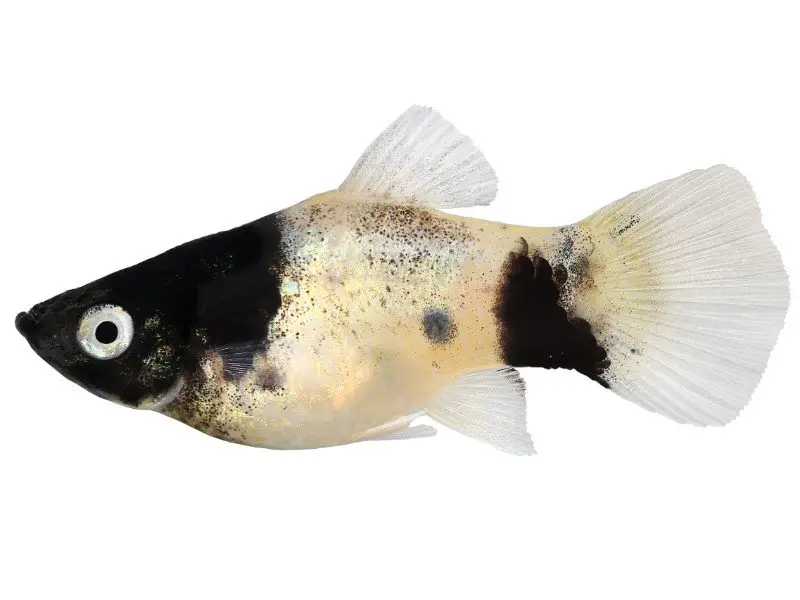
| Care level: | Temperament: | Color: | Lifespan: | Size: |
| Easy | Peaceful | White with black fins | 3–5 years | 3 inches |
| Water temperature: | Water pH: | Tank size: | Diet: | Scientific name: |
| 72–75°F | 6.8–8.0 | 10 gallons | Omnivore | Xiphophorus maculatus |
The panda platy fish is popular among aquarists for its panda-like printing. Some panda platies have blue and pink coloring near their gills.
The design of a panda platy fish is an example of a common platy pattern called the wagtail design, which gives the fish solid black fins.
Neon Blue Wagtail Platy Fish
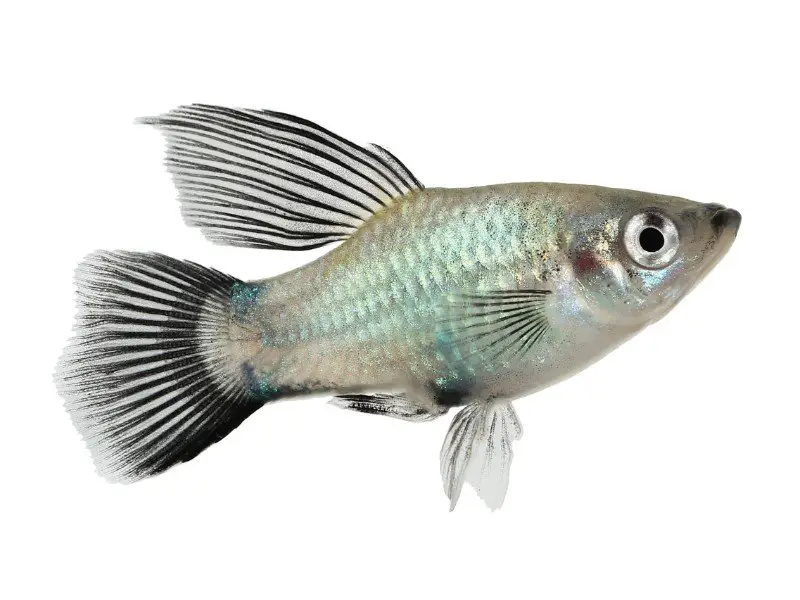
| Care level: | Temperament: | Color: | Lifespan: | Size: |
| Easy | Peaceful | Blue | 3–5 years | 3 inches |
| Water temperature: | Water pH: | Tank size: | Diet: | Scientific name: |
| 72–75°F | 6.8–8.0 | 10 gallons | Omnivore | Xiphophorus maculatus |
The neon blue wagtail platy fish is probably the most common example of the wagtail design.
Neon blue wagtails have the typical dark fins, but these are contrasted by a vibrant neon blue that covers the body. This makes the neon blue wagtail platy an excellent choice for brightening up a dark aquarium.
Stocks of neon blue wagtail platies are not as extensively bred compared to other types. It may be tough to find this platy, but it’s worth buying if available.
Mickey Mouse Platy Fish
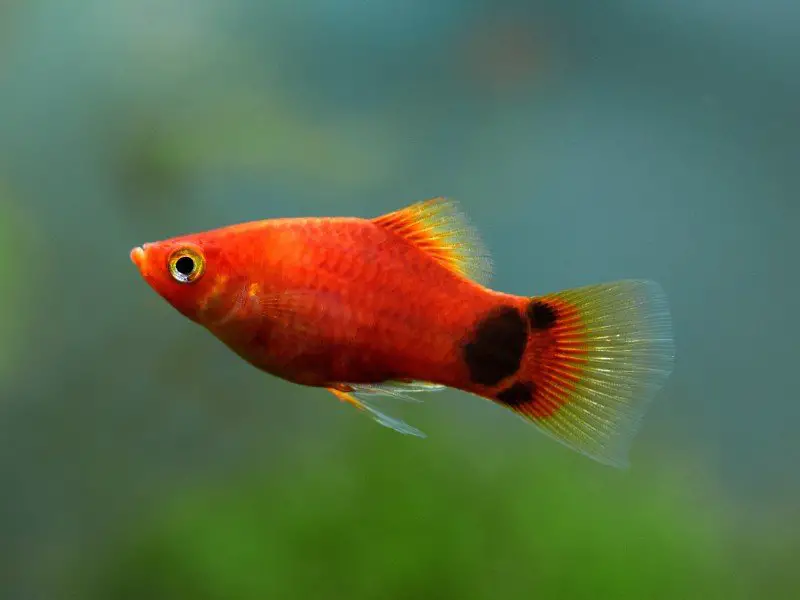
| Care level: | Temperament: | Color: | Lifespan: | Size: |
| Easy | Peaceful | Various, with black spots at base of tail | 3–5 years | 3 inches |
| Water temperature: | Water pH: | Tank size: | Diet: | Scientific name: |
| 72–75°F | 6.8–8.0 | 10 gallons | Omnivore | Xiphophorus maculatus |
The Mickey Mouse platy is one of the most distinctive types of platy fish. A large spot on the base of this platy’s tail is connected to two smaller spots, which together resemble the head of the famous Disney character, Mickey Mouse.
This design is a result of extensive selective breeding, and makes this one of the more difficult platy species to find stocked in local fish stores.
Swordtail Platy Fish
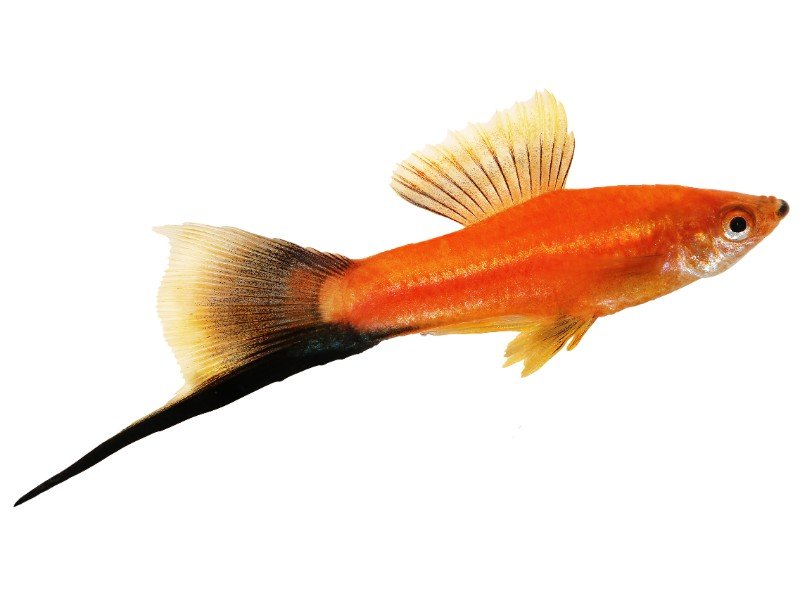
| Care level: | Temperament: | Color: | Lifespan: | Size: |
| Easy | Peaceful | Various | 3–5 years | 3 inches |
| Water temperature: | Water pH: | Tank size: | Diet: | Scientific name: |
| 72–75°F | 6.8–8.0 | 10 gallons | Omnivore | Xiphophorus maculatus |
All the types that have been discussed so far are varieties of southern platy fish. Swordtail platy fish are a separate species. The two species are closely related, and look very similar, but they are genetically distinct.
Swordtail platy fish have an extension from the base of their tail fin. This unique feature has made the swordtail platies particularly desirable, so they are easy to find in stores.
Swordtail platies are just as easy to care for as southern platy fish, but they prefer slightly warmer water than southern platies.
Choosing & Caring for Different Platy Fish Types
There are numerous types of platy fish, many more than could be listed here. Most types vary aesthetically, but there are a few different fin shapes and species to be aware of.
Since platy species are often bred together, you can expect to see new platy varieties appear in your pet store frequently. Look for varieties that display new combinations of fin shapes and colors.
Choosing the right type of platy for you is based on personal preference. All platy fish are peaceful and easy to care for. Avoid those with longer fins if you plan to match your platy with a tank mate that is a notorious fin-nipper.
A large number of platy types available means there is probably at least one that you will like. No matter which color or pattern you pick, the platy is sure to brighten up your aquarium.

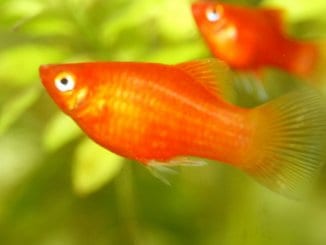
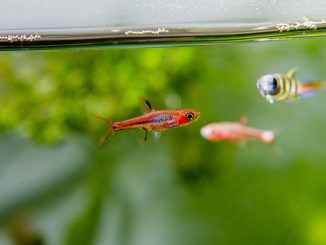
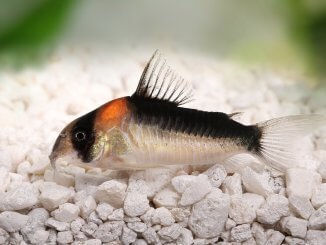
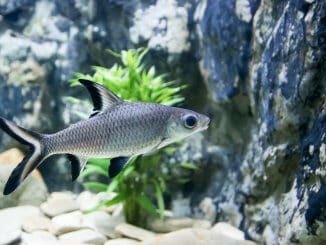
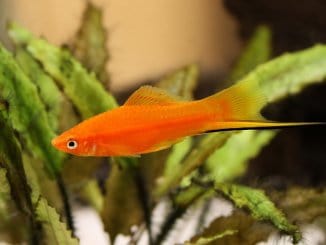
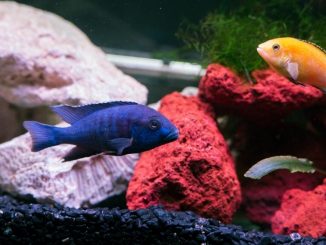
Be the first to comment